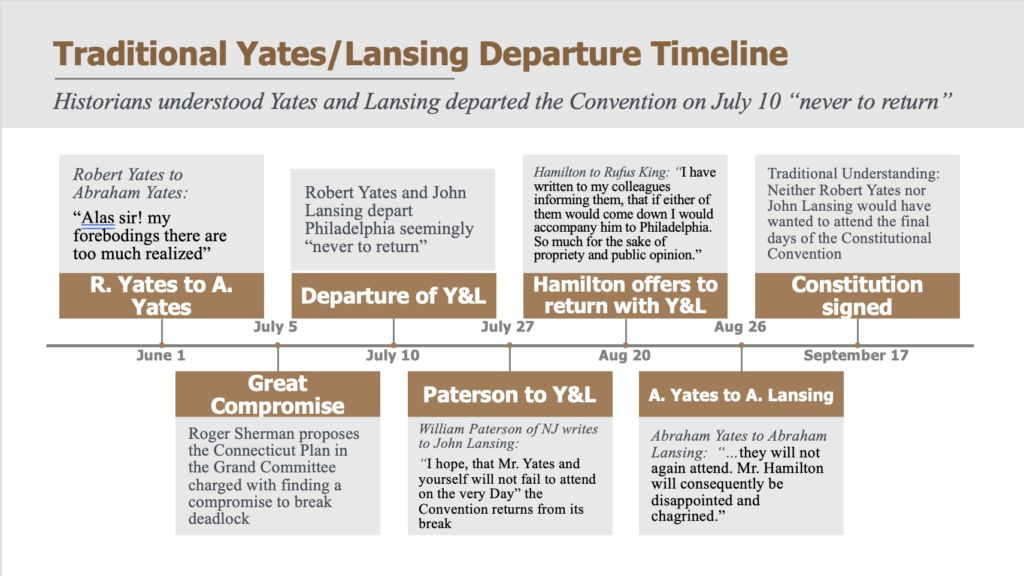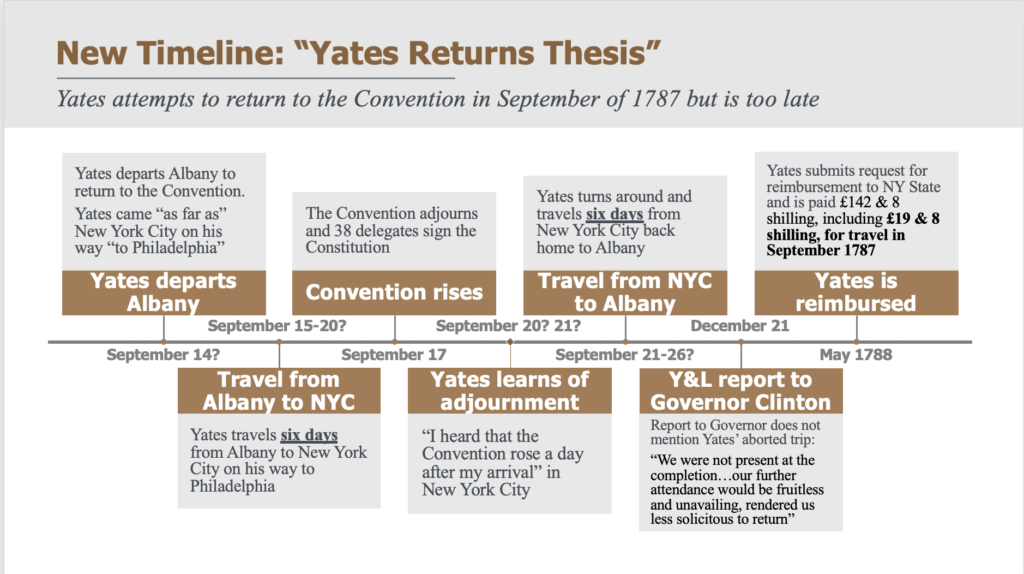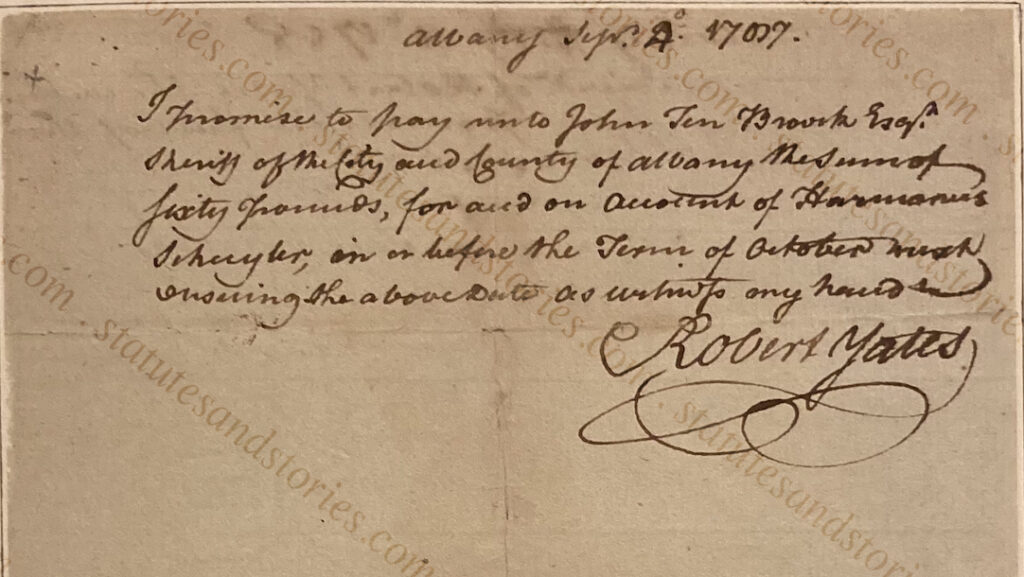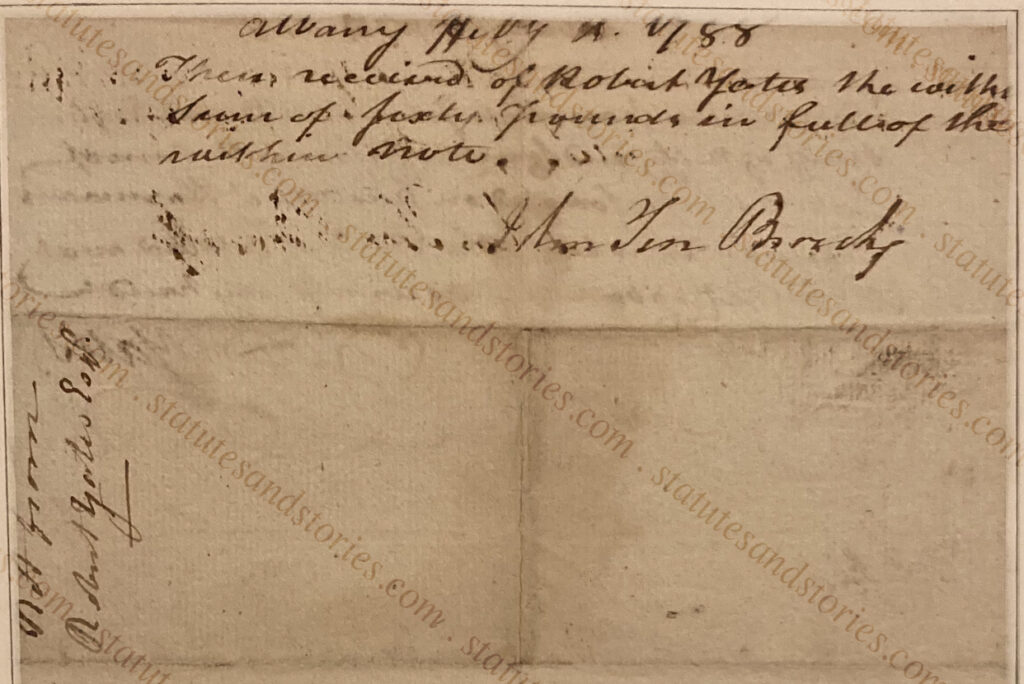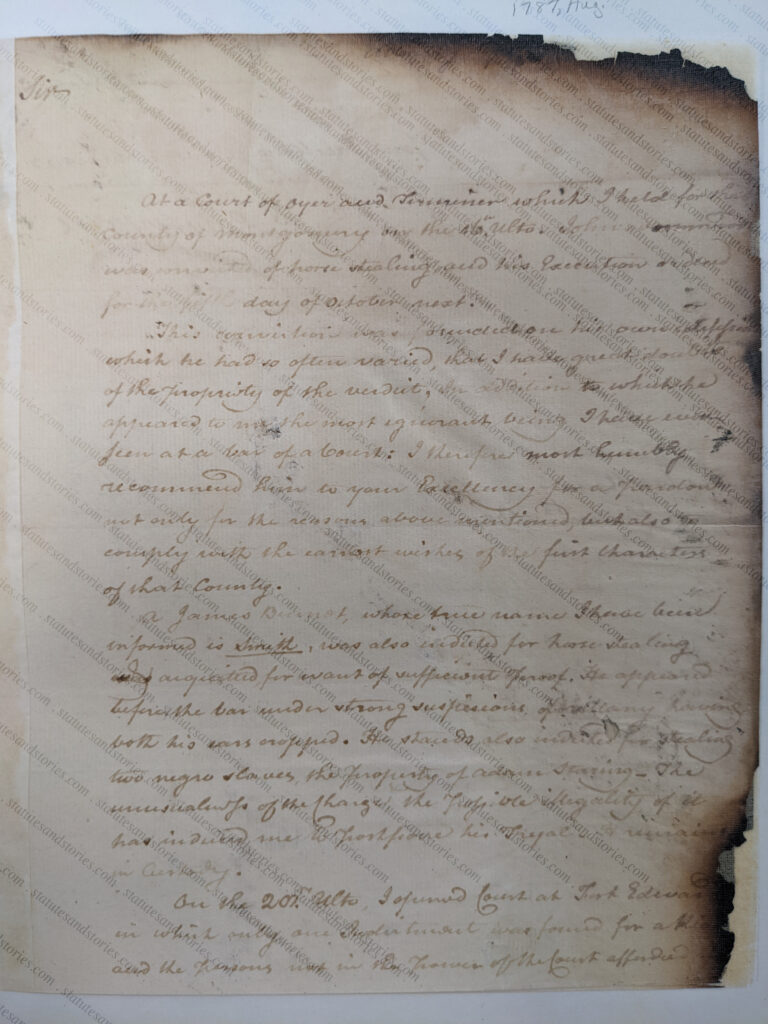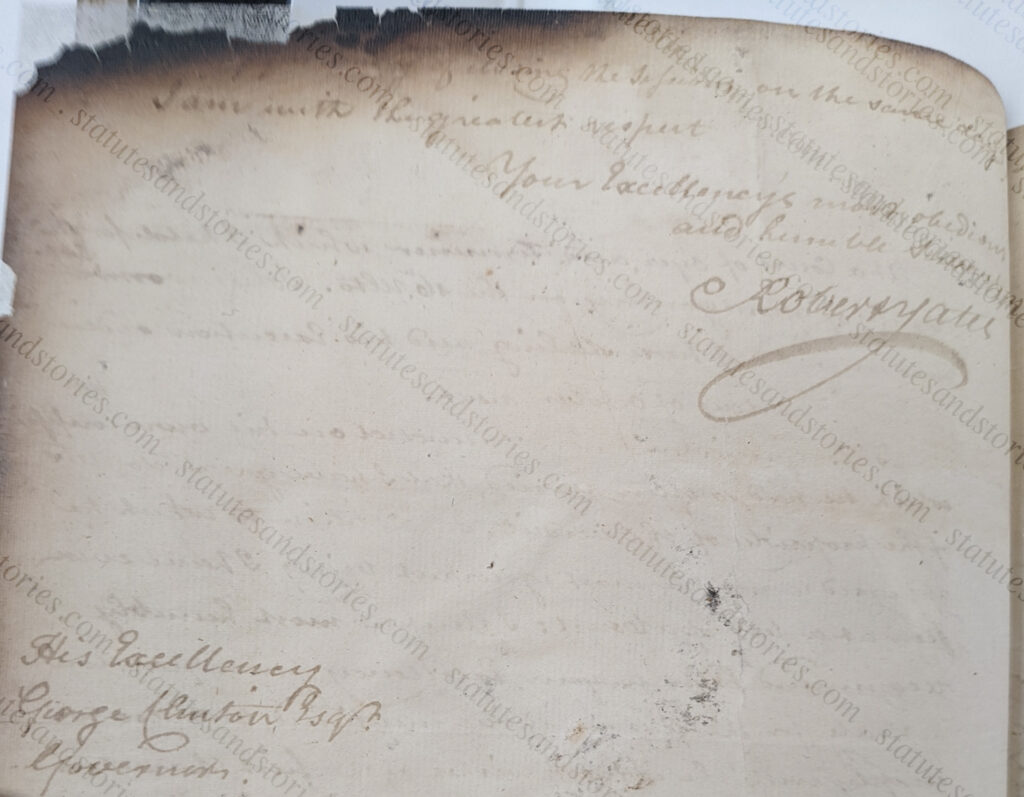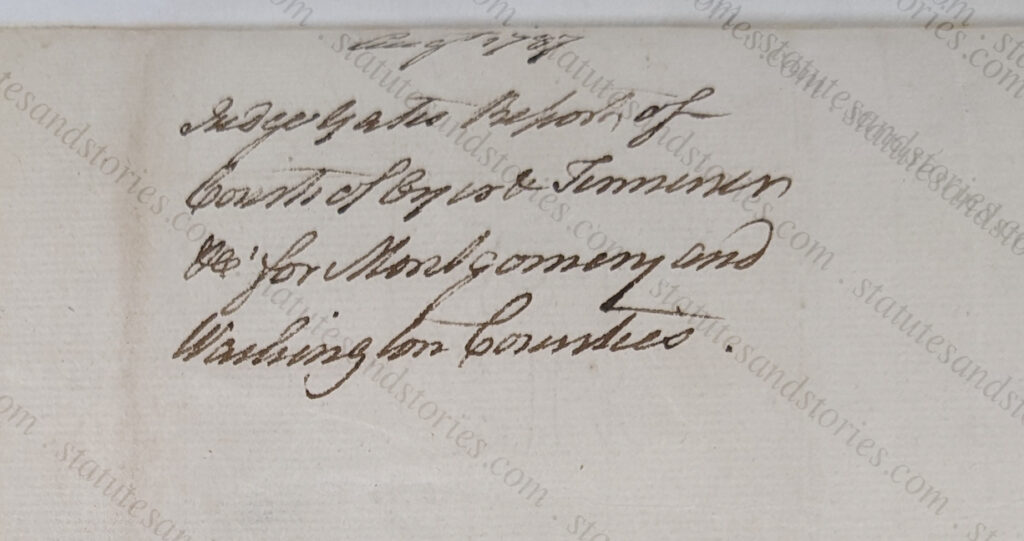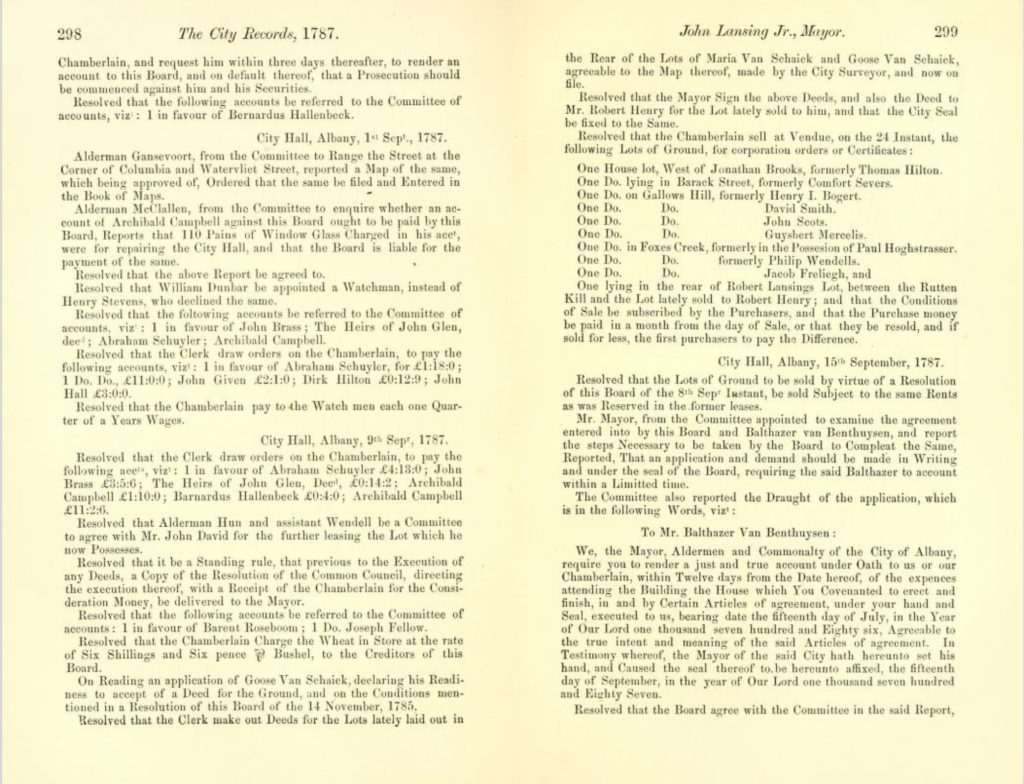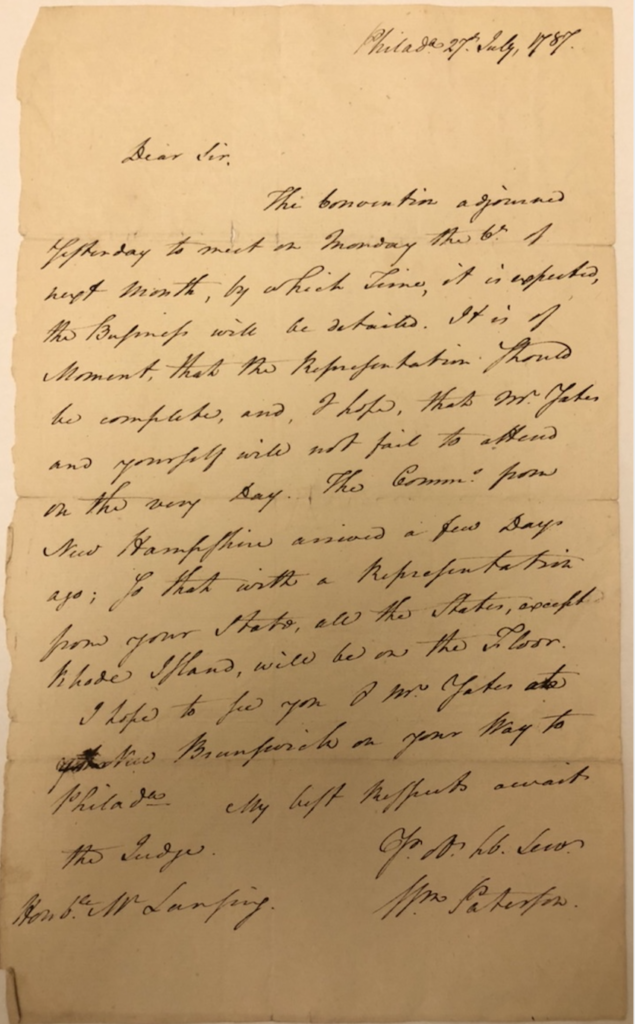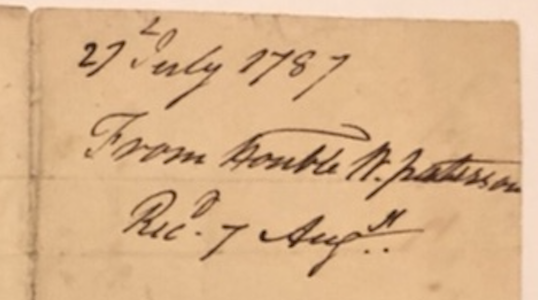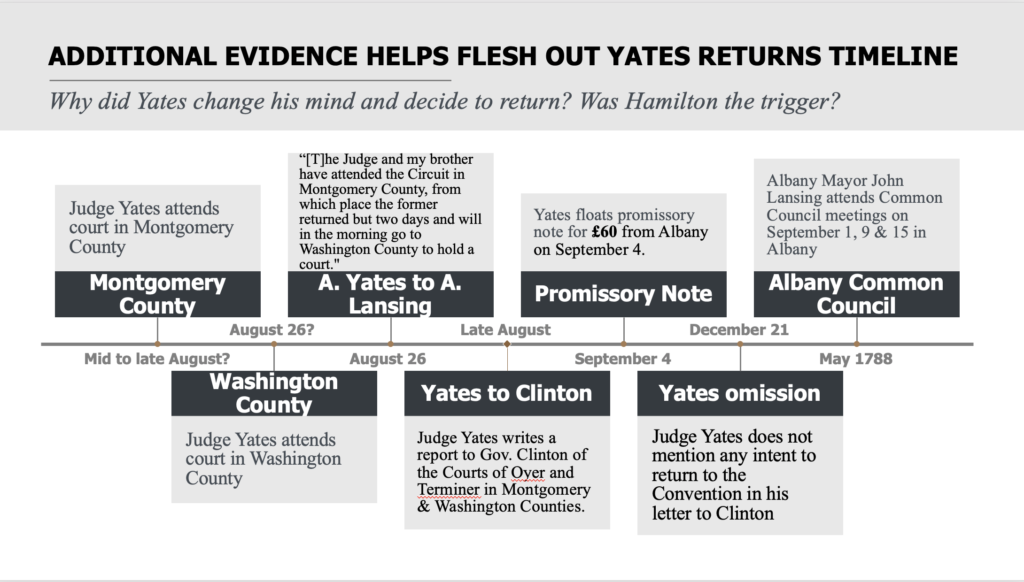Yates Returns Thesis – Part IV
Last year it was discovered that New York delegate Judge Robert Yates attempted to return to the Constitutional Convention in September of 1787. This surprising revelation raises more questions than it answers. The “Yates Returns Thesis” theorizes that Yates’ reason for returning to the Convention was to prevent Alexander Hamilton from signing the Constitution. This post (Part IV) provides an update based on additional archival records located to date.
The expanding list of sources discussed below helps flesh out the activities of Judge Robert Yates and John Lansing in the late summer and early fall of 1787. After summarizing the reasons why historians believed that Yates and Lansing were not expected to return to Philadelphia, the post concludes by discussing the “revised” timeline of when Yates must have changed his mind. The “traditional” timeline of Yates’ activities in the summer of 1787 is pictured below.
According to records of the New York State Auditor discovered in 2021, Judge Yates requested payment of £ 19 and 4 shillings from the State of New York. This sum represented twelve days of travel at 32 shilling per day from Albany to New York City. Click here for a link to Yates Returns – Part I. Upon learning that the Convention had “risen,” Yates discontinued his trip to Philadelphia and returned home to Albany.
This information helped shed light on other discoveries involving delegate compensation. Yates was paid a total of £ 142 and 8 shillings “for his service” as a delegate at the Constitutional Convention, while Alexander Hamilton was only paid £ 121 and 12 shillings. Click here for a link to Yates Returns – Part II. Why was Robert Yates reimbursed more than Alexander Hamilton, when Hamilton spent more time at the Convention? The answer is provided by Yates’ aborted return trip in September, which is illustrated by the “Yates Returns” proposed new timeline pictured below.
StatutesandStories.com suggests that the discovery of Yates’ effort to return to Philadelphia justifies a careful reexamination of traditional assumptions about a critical month in American history. Click here for a link to Yates Returns – Part III – which explored Yates’ motivations for returning to Philadelphia.
Following the “Yates Returns” discovery, previously mundane records have taken on added significance. For this reason, StatutesandStories.com worked with several research institutions to cast a wide net searching for evidence of Yates and Lansing’s schedule in September of 1787. Special thanks are owed to the following archivists: Jill Reichenbach (New York Historical Society), John Diefenderfer (New York State Archives), Cara Dellatte (New York Public Library) and Craig Carlson (Director of the Albany Hall of Records). Loretta Deaver at the Library of Congress assisted with the impossible task of trying to disprove a negative, as will be discussed below in connection with a review of the Papers of William Paterson.
This article – Part IV – analyzes additional primary sources which have been located following the Yates Returns discovery in late 2021. The records discussed below provide further support for the Yates Returns Thesis. StatutesandStories.com invites feedback from scholars regarding the following records, which in several cases are being digitized for the first time in this post:
- Promissory note for £ 60 by Robert Yates dated 4 September 1787 (New York Historical Society);
- Report by Judge Robert Yates to Governor George Clinton of the proceedings of the Court of Oyer and Terminer for Montgomery and Washington Counties in August of 1787 (New York State Archives);
- Minutes of the City of Albany Common Council for September of 1787 evidencing attendance at City Hall by Mayor John Lansing on September 15 (Albany Hall of Records);
- Letter from William Paterson to John Lansing dated July 27 requesting that Yates and Lansing return to the Convention (New York Historical Society); Hutson’s Supplement to Farrand at p. 195.
While none of these records directly verify Robert Yates’ effort to return to Philadelphia in September, these records help establish a timeline for his travels. Most importantly, it is entirely reasonable to presume that the reason why Robert Yates floated the £ 60 promissory note on September 4th was to raise hard currency for his return trip to Philadelphia. As one of the highest-paid state employees in 1787, Judge Yates likely would not have needed the funds for any other purpose the week he departed for Philadelphia.
Additionally, the records discussed below verify the long-held understanding that John Lansing, New York’s third delegate to the Constitutional Convention, did not attempt to return to Philadelphia. It would have been unnecessary for both Yates and Lansing to take the return trip to the Convention, since either one of them would have been able to split the New York delegation and oppose Hamilton. In fact, because Yates was a sitting and well-respected judge, he arguably had more influence on the floor of the Convention than Lansing. This assumes that one of Yates’ objectives was to convince other delegates not to sign the Constitution.
September 4 promissory note by Yates:
Pictured below is the front and back of a promissory note from Robert Yates to John Ten Broeck, executed on September 4, 1787. The promissory note is housed among the 20,000 linear feet of archival materials at the New York Historical Society (barcode: 4503848-10), but has never been digitized for access by researchers.
Yates’ promissory note indicates that:
- Robert Yates borrowed £ 60 from John Ten Broeck, “for and on account of Haramanus Schuyler”
- The note was signed in Albany on September 4, 1787
- Ten Broeck was the sheriff of the City and County of Albany
- The verso of the note verifies that Yates repaid Ten Broeck in full in February of 1788.
The promissory note is noteworthy for several reasons. First, the fact that Yates needed to borrow £ 60 in September of 1787 is significant. Presumably, the reason he was borrowing the funds was to cover the cost of his trip to Philadelphia. Unlike most other states in attendance at the Convention, New York did not advance funds to its delegates prior to their departure. Thus, Yates would have personally underwritten the cost of his initial trip to Philadelphia in May. Click here for a discussion of the Delegate Compensation paid by the states in attendance at the Convention.
Second, the promissory note places Yates in Albany on September 4. It is entirely possible that this promissory note was the last document signed by Yates before he left for Philadelphia the following week. We know from Yates’ request for reimbursement that he traveled from “the place of his abode” in Albany “for the same purpose” as the fifty-nine days he was serving as a “delegate in Convention at Philadelphia…” While we don’t know precisely when in September Yates left Albany, he learned that the “Convention rose a day after my arrival” in New York City. Yates billed the state of New York £19 & 4 shilling for a total of “12 days,” 6 days in each direction “at the same rate” of 32 shilling per day.
It is reasonable to surmise that Yates departed Albany for Philadelphia on or around September 14. Yates arrived in New York City six days after leaving Albany. According to Yates, he learned that the Convention had risen one day after his arrival in New York City. The Convention adjourned on September 17. Thus, Yates likely would not have arrived in New York City prior to September 20, when news of the signing of the Constitution first became public in New York. For example, William Jackson, the Convention Secretary, departed Philadelphia with the Constitution on September 18th and arrived in New York on September 20.
Convention Secretary Robert Jackson departed Philadelphia with the Constitution on the morning of September 18th and arrived at Congress in New York City on September 20th. Jackson traveled with several other Convention delegates who were also members of Congress. Congress would subsequently vote on September 27 to send the Constitution to the states for ratification. Click here for a discussion of the debate in Congress as described in Melancton Smith’s notes.
It is also noteworthy that Yates obtained the £ 60 from John Ten Broeck. At the time, John C. Ten Broeck was the sheriff of Albany. This may explain why Ten Broeck had access to hard currency (specie). Access to hard currency obviated the need to convert less desirable New York dollars into local Pennsylvania currency. The money was borrowed “for and on account of Haramanus Schuyler.”
Ironically, Haramanus Schuyler was related to Alexander Hamilton’s father-in-law, General Philip Schuyler. One can only ask whether Haramanus knew Yates’ reasons for borrowing the funds. Moreover, the other creditor/witness on the note, John Ten Broeck, would become a Federalist and political adversary of Yates. Ten Broeck was defeated in his campaign to be elected as a Federalist delegate to the New York Ratification Convention in Poughkeepsie. Yet, Ten Broeck’s relative, Abraham Ten Broeck, was a Federalist delegate to Poughkeepsie who received more votes than any other Federalist candidate from Albany County. Of course, John Lansing and Robert Yates were leading Anti-Federalists at the Ratification Convention. Click here for a list of the candidates and election results for the 1788 Convention, which is discussed in Volume XXI of the Documentary History of the Ratification of the Constitution (John P. Kaminski, ed. 2005).
Yates’ judicial report to Governor Clinton:
Pictured below is a letter that Yates submitted to Governor Clinton describing court proceedings in August of 1787. Unfortunately, due to fire damage, the date of the letter is not visible. Yet, the fact that Yates’ letter is silent about any plans to return to Philadelphia may be more significant than the content of the letter itself.
Yates’ letter describes proceedings of the Court of Oyer and Terminer in Montgomery County beginning on August 16. For example, Judge Yates recommends that Governor Clinton pardon a defendant scheduled for execution, following a conviction of horse stealing. Judge Yates further reports that on August 20 he “assumed Court at Fort Edwards” which is located in Washington County. Due to the fire damage at the top of the second page it is unclear when Yates completed work in Washington County.
Pictured below is the second page of the letter. Also pictured is the description of the document as “Judge Yates Report of Courts of Oyer and Terminer for Montgomery and Washington Counties.” The year and month is also identified, but not the date in August.
The letter is consistent with correspondence between Abraham Lansing and Senator Abraham Yates. On August 26, Abraham Lansing wrote that “[t]he Judge and my brother” had attended court in Montgomery County. Thereafter, Judge Yates was scheduled to travel “to Washington County to hold Court.” “I find but little inclination in either of them to repair to Philadelphia and from their general observations I believe they will not go.”
The Judge and my Brother have attended the Circuit in Montgomery County, from which place the former returned but two Days and will in the Morning go to Washington County to hold a Court. I find but little Inclination in either of them to repair again to Philadelphia and from their General Observations I believe they will not go. Early in the Commencement of the Business at Philadelphia, my Brother informed me that he was in sentiment with a respectable Minority of that Body, but that they had no prospect of succeeding in the Measures proposed and that he was at a stand whether it would not be proper for him to leave them. This Circumstance convinces me the more that they will not again attend. Mr. Hamilton will consequently be disappointed and chagrined.
Mayor Lansing remained in Albany:
It was relatively easy to verify that John Lansing stayed home in Albany. To begin with, Lansing never suggested in his request for reimbursement that he traveled with Yates in September. Moreover, readily available minutes of the Albany City Commission (Common Council) confirm that Mayor Yates attended to City business at meetings on September 1, 9 and 15. It is unclear from the meeting minutes whether Lansing attended Common Council meetings on September 22 or 25, but elections were held on September 25. This post will be updated when pending research requests become available.
Pictured below are the minutes of September 9 and 15th reflecting Mayor Lansing’s attendance to City business in Albany. The minutes were published by Joel Munsell in 1867 in Vol 2 of the Collections on the History of Albany.
Paterson letter:
Before Yates and Lansing departed the Convention on July 10, they were allied with small state delegates who supported the New Jersey Plan. Pictured below is a letter from New Jersey delegate William Paterson to John Lansing on July 27, requesting the Yates and Lansing return to the Convention in August. The text of the letter can be found in Hutson’s Supplement to Farrand at p. 195.
Paterson wrote that:
The Convention adjourned yesterday to meet on Monday the 6th of next Month, by which Time, it is expected, the Business will be detailed. It is of Moment, that the Representation should be complete, and I hope, that Mr. Yates and yourself will not fail to attend on the very Day….I hope to see you and Mr. Yates at New Brunswick on your Way to Philadelphia.
The Convention recessed between July 26 to August 6 to permit the Committee on Detail to complete their preliminary draft of the Constitution. Paterson was the author of the so-called New Jersey Plan. Paterson’s New Jersey Plan was offered by the small states as an alternative to the Virginia Plan which was supported by the large states of Virginia, Pennsylvania and South Carolina. Although New York was a large state, Yates and Lansing supported the New Jersey Plan’s limitations on federal authority, in contrast to the more nationalistic Virginia Plan. As a result, Paterson, Yates and Lansing were allies who voted together at the Convention in opposition to Hamilton, Madison and the Pennsylvanians. This explains why Paterson would have wanted Yates and Lansing to return to the Convention in August.
Professor Jack Rakove asks whether the New Jersey Plan was meant to be taken seriously on its merits, given its major weaknesses. Rakove asserts that the only arguments made in support of the New Jersey Plan were that the delegates didn’t have any right to replace the Articles of Confederation and that there was very little chance that the radical Virginia Plan would ever be adopted. These were the principal reasons cited by Lansing and Paterson in their speeches on June 16.
There is no record that Lansing or Yates replied to Paterson’s letter. For example, neither Max Farrand nor James Huston identified any response by Yates or Lansing. The papers of William Paterson are housed at the Library of Congress. Loretta Deaver, a Reference Librarian at the Library of Congress, was kind enough to confirm that she searched “the miscellaneous material relating to the Convention and the miscellaneous correspondence within the William Paterson papers, but did not locate any letters from Robert Yates or John Lansing.”
There are several possible explanations. It is possible that Lansing and Yates did reply, but their letter may not have been preserved. Assuming that Lansing and Yates never replied to Paterson, as of early August they may not yet have decided what they were going to do. Or, it is more likely that they simply had no intention of returning. This of course begs the question: Why did Yates decide to return to the Convention at the last minute in September? This question is addressed in Yates Returns – Part III.
Traditional sources evidencing no intent to return in August
So when did Yates change his mind? Based on the date of the promissory note, Yates seemingly made the decision to return on or about September 4. This is consistent with the following evidence traditionally relied on by historians that Yates had no intention of return in August:
- Robert Yates to Abraham Yates (June 1) indicating that his fears were being realized at the Convention and it remained to be seen how long he would stay [Hutson’s Supplement to Farrand at p. 41]:
Alas sir! my forebodings there are too much realized, and to prevent any member from communicating the future proceedings of Convention additional Rules have since been entered into, one of which strictly prohibits the communication of its business until the final close of it. While I remain a sitting member these rules must be obligatory. How long I shall remain future events must determine. I keep in the meanwhile an exact journal of all its proceedings. This communication is in the most perfect confidence, in which only one other Person beside yourself can participate. My respectful compliments to the Governor and remain Sir Your most obedient humble Servant Robert Yates
- Alexander Hamilton to Rufus King (July 20) indicating that although he had written to Yates and Lansing inviting them to return with him to Philadelphia he was doubtful that they would return [3 Farrand at p. 70]:
I have written to my colleagues informing them, that if either of them would come down I would accompany him to Philadelphia. So much for the sake of propriety and public opinion.
- Abraham Yates to Senator Abraham Lansing (August 26) expressing serious doubts that Yates or Lansing would return to the Convention [Hutson Supplement to Farrand at p. 242]. In his August 26 letter, Abraham Yates wrote that “I find but little inclination in either of them to repair to Philadelphia and from their general observations I believe they will not go.” Senator Yates added that their absence would leave Alexander Hamilton “disappointed and chagrined.” This of course assumes that Hamilton’s objective was for the New York delegation to be represented by a quorum of New York delegates. Little did Senator Yates realize that Hamilton had other plans – and would wind up signing the Constitution in his own right – even though the New York delegation lacked the requisite quorum:
The Judge and my Brother have attended the Circuit in Montgomery County, from which place the former returned but two Days and will in the Morning go to Washington County to hold a Court. I find but little Inclination in either of them to repair again to Philadelphia and from their General Observations I believe they will not go. Early in the Commencement of the Business at Philadelphia, my Brother informed me that he was in sentiment with a respectable Minority of that Body, but that they had no prospect of succeeding in the Measures proposed and that he was at a stand whether it would not be proper for him to leave them. This Circumstance convinces me the more that they will not again attend. Mr. Hamilton will consequently be disappointed and chagrined.
- Yates and Lansing to Governor Clinton (December 21) explaining the reasons why they departed the Convention in July and were not present on September 17 [3 Farrand at p. 244]:
“We were not present at the completion….but before we left the convention, its principles were so well established as to convince us, that no alteration was to be expected….our further attendance would be fruitless and unavailing, rendered us less solicitous to return.”
- Luther Martin to the Maryland House of Assembly (January 4, 1788) indicating that when Yates and Lansing left the Convention they had “uniformly” opposed the proposed Constitution and “returned no more” [Genuine Information III]:
“The Honourable Mr. Yates and Mr. Lansing of New-York left us – They had uniformly opposed the system, and I believe, despairing of getting a proper one brought forward, or of rendering any real service, they returned no more…”
This information is summarized in the “traditional” timeline contained at the top of this article. By contrast, the “Yates Returns” timeline outlines when Yates likely departed Albany in September to return to Philadelphia. The additional evidence accumulated in 2022 is contained in the expanded timeline set forth below:
Thus, we can readily confirm based on the Albany Common Council minutes from September that John Lansing did not attempt to return to Philadelphia with Robert Yates. It remains a mystery, however, why Yates changed his mind. StatutesandStories argues in Parts II and III that Alexander Hamilton’s reappearance in early September may have been the trigger. While Hamilton attended for a single day in August, this brief appearance on August 13 was not enough to prompt Yates to return.
Yet, Hamilton’s election to the Committee of Style on September 8th may theoretically have pushed Yates over the edge. While this explanation makes sense, it would have required a mole at the Convention who promptly reported back to Yates, along with the quick delivery of the message.
Based on Yates’ reimbursement requests we know that it takes approximately 6 days to travel from Albany to New York City. The trip from New York City to Philadelphia takes another 2 days. If the messenger left on September 8th, Yates would have been on notice of Hamilton’s appointment on or about September 15th. If Yates had left shortly thereafter, he would have arrived in New York on or about September 21st.
The September 4 date of the promissory note rules out the possibility that Hamilton’s appointment to the Committee on Style on September 8 was the sole trigger for Yates. One possibility of reconciling the two dates might be that Yates received preliminary news in early September that Hamilton would be traveling to Philadelphia (or had left). This may have prompted Yates to take out the loan. Upon learning that Hamilton was appointed to the Committee on Style, Yates would have been ready to fly if he needed to leave. But it turned out that he was not fast enough.
This post continues in Part V, which discusses Judge Yates’ court cases in 1787 that relate to the Yates Returns timeline.
